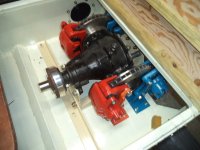A valid point - look closely at the middle photo and you'll see the rubber tread that I cut off the original tire - that should add some cushioning. There should be no direct wood-to-metal contact occurring on except on the sides. I am not worrying about the wooden construction too much as it is made from multi-ply plywood with cherry and oak on the outside faces for wear resistance. It is all glued together with Gorilla urethane glue and should not come apart. I'd gladly like to hear if anyone has a different suggestion on how to make a 5" wide, 16" OD flat-proof tire to handle side loading. Keep in mind I did look into filling the original trailer tires with 2-part rigid foam but it was expensive at about $130 per tire. As a side note, I plan to install the previously defined chain drive system to the rear sprockets this spring. Due to the tight spacing between the tire supports and the frame, I have to reduce side-to-side movement of the tracks so collisions do not occur. The new wider wooden wheels should do that (I hope).
![20231217_111134[1].jpg](/forums/data/attachments/746/746375-a942e36fe092408b5a13bc8c1f85cae5.jpg)
![20231220_092457[1].jpg](/forums/data/attachments/746/746376-79e0eb6bf469f2c2305980e6f4318882.jpg)
![20240102_133616[1].jpg](/forums/data/attachments/746/746377-c50ee86aa3482f6d29a409e879a48901.jpg)
![20240115_133101[1].jpg 20240115_133101[1].jpg](https://www.tractorbynet.com/forums/data/attachments/746/746654-6c47e0d253f75dc127e43eb51eb27cec.jpg)
